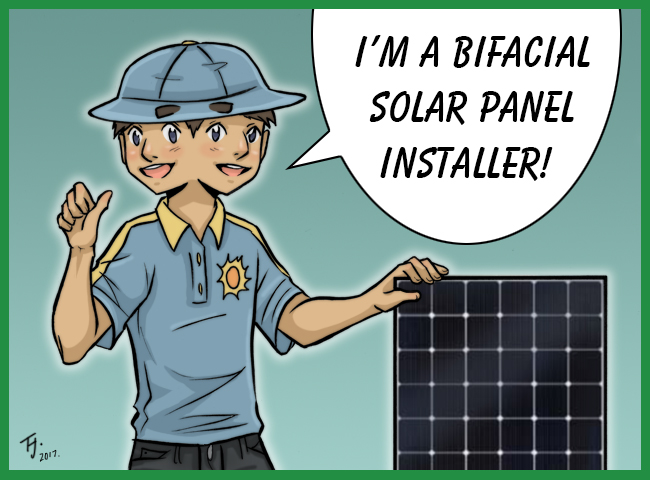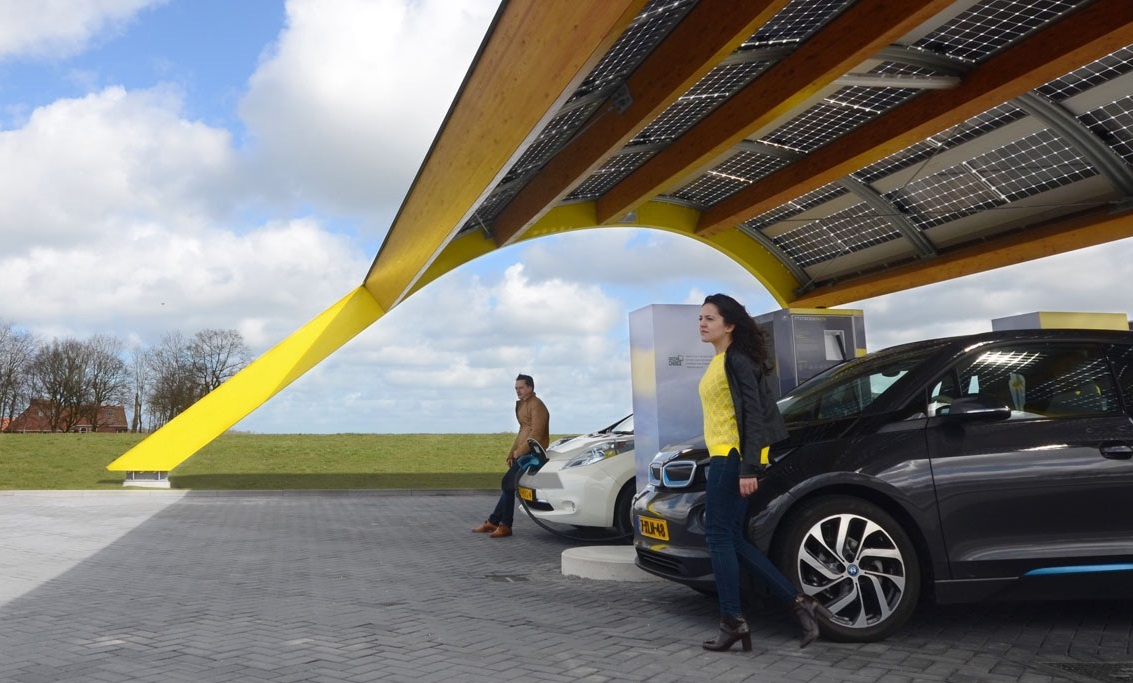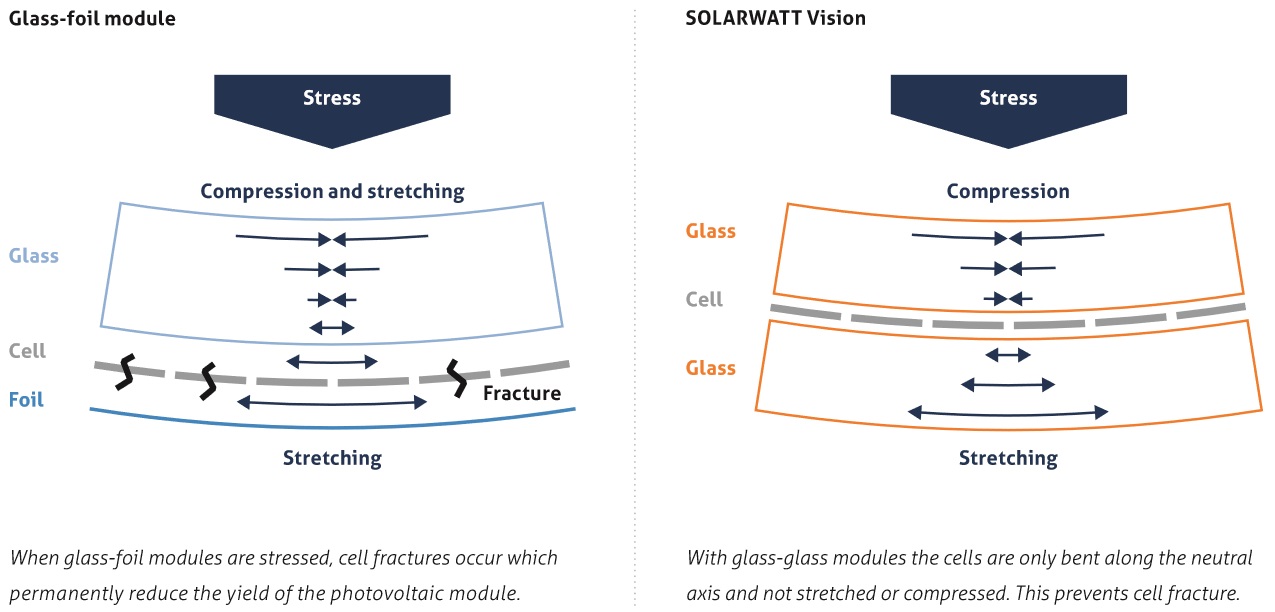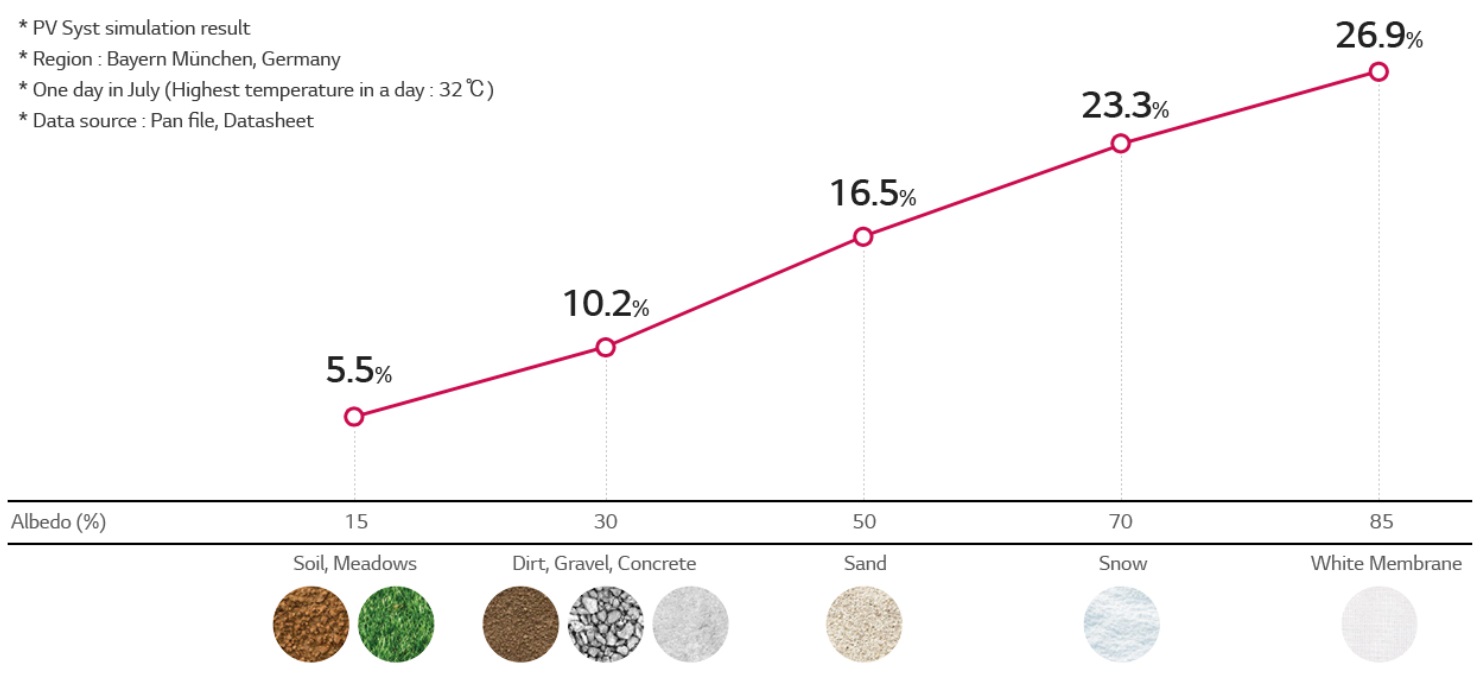
Glass is a vital part of almost every solar panel installed on Australian roofs. The sheets of glass used to protect solar cells are long lasting, non-reactive, very tough, and — above all else — it’s transparent. As a result glass functions far better than wood, cheese, iron, or mucus.
While not as strong as diamond or transparent aluminium1 it does have a significant cost advantage over those materials.
Because glass is such a great material for the front of solar panels, at some point a bright spark decided it would be even better to have glass on the back as well. And you know what? He or she was right. Glass backing is superior to the plastic backsheet used in standard solar panels, but has the disadvantages of being heavier and more expensive.
Too Much Terminology
Another disadvantage of using two sheets of glass to make a solar panel sandwich is there is no good agreement on what to call them. Terms used in the order of most Google love to least Google love are:
- Glass-glass
- Double glass
- Glass-on-glass, and…
- Dual glass
The term I tried to popularize, “crunchy silicon sandwich” has precisely zero hits, so clearly I am not the funky trendsetter I always thought I was. Because I think the popularity of the term glass-glass is due to its use in Germany2, I will use the more euphonious name double glass, which I think rolls off the tongue of English speakers a little better.
Bifacial Solar Panels
Another important term is “bifacial” which is used for solar panels that can use of light coming from the front as well as the rear. All bifacial panels are double glass, but not all double glass panels are bifacial. I think the term bifacial sounds a little strange, but if they had called them Janus panels very few people would get the joke and if they called them two-faced panels they would carry a bad connotation. Namely Tommy Lee Jones’s acting in Batman Forever:
Double Glass Panels Are Durable
Glass doesn’t have a great reputation for resilience. We say delicate things are fragile as glass, we describe a boxer with an easily broken mandible as having a glass jaw, and I have a heart of glass because I am sensitive yet quick to love. Also because I eat chocolate coated bacon three times a day.
I thought people’s estimation of the strength of glass would increase because so many of us carry around an incredibly tough sheet of it less than a millimeter thick on the front of our smart phones. But because we all too often pay ridiculous amounts of money for our electronic squawk boxes, when it does break it makes us completely forget about all the times it didn’t.
The glass used on solar panels is strong enough to withstand 2.5 cm hail, which is as large as it normally gets. Unfortunately, things aren’t always normal in Toowoomba and during one storm fist sized hail started smashing through our roof. Solar panels won’t survive rare, giant, horse killing3 hail stones, but they will stop a hole being punched through your roof, so their sacrifice won’t be in vain.
Solarwatt is a German company that only makes double glass solar panels. At just 2 mm thick they use the thinnest sheets of glass in the solar industry I know of, which allows their panels to be no heavier than standard ones. But despite only having a total of 4 mm of glass, they can survive being jumped on or smashed with a hammer, as this short film demonstrates:
Unfortunately, this video has no sound and so I strongly suggest everyone write to Solarwatts4 and demand they pay Arnold Schwarzenegger to dub in the word “boing” every time someone jumps on the panel or hits it with a hammer. The great thing about this suggestion is his ridiculous Austrian accent will also make it funny for Germans5. For the slow motion shots he should say, “BOOIIIINNNNNNNGGG!”
While the thin glass panel does not break, despite all the abuse it is given, you can see being smashed with a mallet does leave some marks and they are not good for the panel. Also, all that flexing can damage the solar cells and wiring inside. But according to Solarwatts, the damage will be less than with a conventional panel with a plastic backsheet.
Flexing Causes Fewer Microcracks
Solarwatts says when a standard solar panel is flexed by wind, snow piling up, or people jumping on it while Arnold Schwarzenegger says “boing”, the solar cells won’t only be bent, but will also be stretched, contributing to microfractures that degrade panel performance. But stretching apparently does not occur with double glass panels, as this Solarwatts diagram demonstrates. (For some Germanic reason they call standard panels “glass-foil”.):
Of course, you’d expect a company that only makes double glass panels to say good things about them, but if you can’t trust Germans who can you trust6?
Glass Is Non-Reactive
Glass is very non-reactive and so, provided it is not smashed, under most conditions can remain almost unchanged for thousands of years7. For example, this wine bottle is around 1,700 years old. Because glass is non-reactive, chemical reactions won’t occur between it and the solar cells or the epoxy that bonds panels together. While plastic backsheets are not very reactive, glass is in a whole different class.
Double Glass Can Reduce PID
Because glass is non-reactive and two layers does a great job of keeping water out of the panel, double glass panels can reduce, or possibly eliminate, damage caused by Potential Induced Degradation or PID. This is caused by stray electrical currents going where they shouldn’t. It’s worse is humid climates with high temperatures, causes marks that look like snail trails, degrades panel performance, and can eventually cause them to fail.
Bifacial Solar Panels Like It Both Ways
Nearly all solar panels have a reflective layer on the bottom of their solar cells so light hitting the bottom of the cell will bounce back through it again to give it a second chance to be absorbed and generate electricity. In a bifacial panel, because the bottom of the solar panel is glass, this reflective layer can be left off to allow light coming from behind the panel as well as the front generate electricity. Even among double glass panels, bifacial ones are still a minority, but they are gaining acceptance and in the future they may be used in solar farms on a large scale.
Bifacial Panels In Racks Produce More Power
When bifacial panels are mounted in tilted racks, light can reflect off the ground and pass through the panel from behind, increasing their performance above conventional ones. According to LG Solar, under perfect conditions their bifacial panel can generate 27% more energy. But I don’t think perfect conditions exist in Australia, unless you happen to own a field full of mirror balls to install them over. Also, their results are based on one clear summer day in Germany so we can only guess how well they’ll perform in reality in Australia.
This graph I stole from LG Solar shows their results when racked up over a variety of different surfaces:
The worst performance is obtained over soil or green grass, where LG’s bifacial panel only produces 5.5% more kilowatt-hours over a sunny day than an otherwise identical standard panel. But grass is a type of living solar panel and doesn’t reflect much light except for green8. Of course, in Australia green grass is an abomination and only exists in Victoria and an insignificant portion of the rest of the mainland. Normally it’s either yellow, brown, grey, or turned to dust and blown away. So in this country bifacial performance over grass may be closer to the figure given for dirt or sand. Unless you put effort into preparing a bright surface and keeping it clean, it may be difficult to get performance much higher than for sand, unless perhaps it is Lucky Bay beach sand which is so white it will make your eyeballs sizzle. In this country don’t go putting hope into “snow” boosting output.
One useful feature of bifacial solar panels is they have improved performance in cloudy conditions compared to standard ones. Or at least they are supposed to. I’m starting to wonder now, because you would think LG would have included cloudy days in their comparison if there was a significant improvement over conventional panels, wouldn’t you? Assuming it is true, this is useful because reduced solar generation can make electricity more valuable when it’s cloudy, especially in winter when clouds and high electricity use for heating go together.
They Like It Both Ways — But The Front Way Is Better
Because there is normally more wiring on the back of a solar cell than the front, and also because there is a junction box and cables on the back that are aren’t transparent, bifacial panels are more efficient at turning light into electricity from the front than from the rear. For example, Longi Solar’s bifacial panel has the best performing rear in the business and, when exposed to equal amounts of light, it will produce 82.15% as much as power as the front. Having one side less less efficient than the other is mostly unavoidable, but isn’t a major problem problem provided you remember not to install them upside down9.
Don’t Install Bifacial Panels On A Normal Roof
Bifacial solar panels will only produce more electricity if light can hit the back of the panel and that is not going to happen when installed flat on a roof. The gap between the panel and the roof is what we scientists call very small and not much light is going to get in there. It doesn’t matter how pearly white your roof is, you will produce more electricity with panels that have a reflective layer on the bottom of the solar cells than bifacial ones. Despite this, I have had a solar panel salesperson tell me a bifacial panel will still generate additional energy when used for a normal roof installation. He seemed nice enough, so either he was dim or a two faced, bifacial bastard.
If you have a flat roof and are mounting your panels in tilted racks, then bifacial solar panels can produce extra energy, especially if you have a shiny white roof. Unfortunately roofs usually don’t stay shiny white for long. They often get grubby because rain doesn’t wash flat roofs clean as well as tilted ones and their material isn’t normally as dirt resistant as glass panels.
Bifacial Panels And Inverter Limits
An interesting feature of bifacial panels is while they can produce extra energy compared to standard ones, this does not appear to affect their capacity rating. So bifacial panels can allow people who are limited in the amount of panel capacity they can install generate more electricity they they would using conventional panels. If the solar panel capacity is at or close to the maximum of 133% of the inverter capacity, then a small amount of the extra energy produced by bifacial solar panels can be lost, but it’s not likely to be much.
The inverter will need to be capable of handling the extra power, but because of the usual 133% limit, it’s very unlikely to be a problem for on-grid installations in Australia.
Double Glass Panels Can Be Used As Roofing Material
Double glass panels have been used as roofing material and this can help offset their cost. For open structures, such as verandah roofs and carports, bifacial panels can allow for extra generation. Double glass panels can also be used for closed structures, but a lot of thought needs to be given to the design because solar panels can get very hot. While it doesn’t happen often, on a hot sunny day panels can hit 65 degrees. Also, sunlight can enter through the gaps between solar cells and this can turn a room into a greenhouse.

This electric car charging station was built by the Dutch and has a roof made of bifacial solar panels. Currently it is not located inside a German compound. (Image Credit: Fastned)
The CSIRO library in Newcastle, NSW installed double glass solar panels as a roof without a ceiling underneath and they ended up using retractable tarpaulins to try to control the light and heat.
Double Glass Warranties Are Better Than Average
Because of their slow rate of deterioration, it is normal for double glass panels, including bifacial ones, to have a 30 year performance warranty that says for up to three decades they will still produce over 80% of their original output.
Solar panels normally have product warranties that are shorter than their performance warranty. Solarwatts offers a 30 year product warranty. That is as long as their performance warranty, but they are Germanic warranty gods and offer the best set of warranties I am aware of.
Here is a list of some double glass product warranties from various manufacturers:
- Solarwatt 30 years
- Solarworld Bisun10 20 years
- LG Solar NeON 2 Bifacial 12 years
- Longi Solar 10 years
- Seraphim Solar 10 years
- Trina Solar Duomax 10 years
As you can see there is a wide range, with the 10 year product warranties being kind of disappointing given they are willing to boost the performance warranty to 30 years. But slapping a long product warranty on something a manufacturer isn’t sure will go the distance isn’t a good idea either.
While I am not a lawyer, it seems clear to me that under Australian Consumer Law a manufacturer will be required to replace panels that fail, through no fault of their user, for their entire performance warranty period which will normally be 30 years for double glass panels. But it is possible you will have to fight the manufacturer and take them to small claims court or a consumer tribunal to get a satisfactory resolution if their product warranty is over. (At the moment we are waiting to see how they respond.) But if you want long lasting panels, because ones with longer product warranties are more likely to be reliable, go with them.
The Future Is Glass — But One Sheet Or Two?
Solar panels are going to have glass on top of them for a long time to come. Even if something revolutionary and new is developed it will probably still need glass on top. Whether or not we’ll see more panels with glass on the bottom is harder to say. While both solar panel and TV screen manufacturers have already put a lot of effort into lowering the cost of tough, high quality, sheets of glass, further reductions seem likely. Also, as more efficiency gains are slowly wrung out of solar cells, the extra cost of double glass per watt of solar panel capacity will decrease. So it is possible it will become common, at least among premium panels.
While bifacial panels won’t see a great deal of residential use, they could still be popular for carports and above patios. I do think there is a good chance bifacial panels will see a lot of use in solar farms, but I’ll save my thoughts on that for another article.
Footnotes
- Yes, transparent aluminium is a thing, we’ve been able to make it for over 100 years, and it wasn’t given to us by Scotty in 1986. ↩
- Oh those Germans and their compound words! They like compounds so much they put my Grandfather in one for a while. ↩
- Rest in peace, Tonto 4, inside whichever meat pies you ended up in. ↩
- I prefer the plural OK? ↩
- If Germans ever deny finding Austrian accents hilarious, don’t worry, they’re just being polite. ↩
- If you put your trust in Germans, they’ll pay you back with compound interest. ↩
- Glass is not a “slow liquid” like I was told as a child. It’s a solid at normal temperatures and won’t gradually turn into a puddle if given enough time. ↩
- When it comes to green, chlorophyll is kind of stupid. But despite there being a variety of different photosynthetic pigments used by life on earth, chlorophyll is still the best for plants to use, despite its habit of rejecting green light. ↩
- I don’t care if it makes the wiring easier. ↩
- Yes, they named their bifacial panel after a bewilderbeast. ↩




 RSS - Posts
RSS - Posts



My prediction. Panels will all be frameless. NO real need for frames. This is how First Solar can get their PV modules so cheap. No frames.
In order to get panels cheaper than they are today you’re going to have to get rid of the frames. When you are installing solar panels on the roof the reason for frames is to have something to clamp the end clamps mid clamps onto the solar collector. There’s no reason why you can’t make a frame or roof mounting system that attaches to just a piece of glass. After all that’s really all the solar panel is ,is a piece of glass with solar cells on it.
Double glass just makes the module twice as heavy and I don’t really think it’s needed. First Solar claims that they’re going to get their panels down to $0.18 a watt. one way they can do this get rid of the frames. They have been in business for over 20 years and have many solar farms operationing all over the world with absolutely no frames.
Tesla, if and when they actually have their solar shingles available and mass marketed, are not going to have frames either. So in my opinion the future of solar will definitely be glass, but we are going to see more and more solar panels and racking systems that support frameless the modules PV modules.
JD
I’m doing my boat with solar, wind and deasil generator back up. It is two floors bottom for living and above deck for GYM, Wheel house, storage of Kayaks, Push bikes, Generator and fuel.
I plan on doing the roof of the top floor with solar panels Like a carport construction with café curtain sides. Would these panels {doubled glass} be more efficient still They sound much better in all ways. I run at the moment on 48V
If the roof is open air they will produce more power as there will be some light coming in from underneath. But if the roof is over a closed cabin they won’t generate more and you could have heat problems as the panels get hot in the sun and air can’t easily circulate to keep them cool.
What is the story with materials in a marine environment?
You would have to be careful wouldn’t you?
I know many stainless steels do very poorly with respect to corrosion if in contact with seawater.
But if you are building a boat I assume you are across these issues.
Also vibration like you get in boats in rougher weather will mean your electrical wiring etc has to be very robust. How do solar panels go with constant vibration?
Solar panels used on a boat would definitely need to be corrosion resistant:
https://www.solarquotes.com.au/blog/salt-mist/
Unfortunately, the warranty of most solar panels states it is void if they are installed on a boat or moving vehicle. There are thin film panels that can be used for such applications, but note their warranties can be much shorter than those of conventional solar panels.
I’m afraid you’ll probably be much better off finding someone else to help you, as I don’t really know much about putting panels on boats.
Hay climate chamnge is a world problem and if some one produced a product where I dont run my dirty gen as much they get my vote and my money.
Please – has anybody got any information about installing these sorts of panels over the top thermal swimming pool heating ‘matting’?
I’ve found one instance of it apparently working (https://www.facebook.com/gippslandsolar/posts/2374580195900207) but I’d certainly welcome anything more that people might have.
thanks!
Thank you Ronald for all the humour you included in this article. I am now well informed, highly amused and tempted to read your other articles for their humour content.
Would you consider bifacial panels with only 2mm front and back glass to be inferior to mono facial that have say 3.6mm glass when it comes to hail impact?
Other than efficiency what other benefits do they have
Thanks
Hi Joe,
Dual glass are all round more durable in my experience.
Interesting demonstration here:
https://www.youtube.com/watch?v=gGwUdV8zjUk&t=31s
Thanks, interesting video
Would you consider the extra additional weight from dual glass panels something to worry about?
In my case I’m looking at 475W 27kg panels X 14 panels on a colorbond roof?
Hi Joe,
When you do the numbers for kg/m² solar never amounts to much compared to the blokes who walk over the roof installing it.
Things are a bit different if you have a close coupled hot water service with 5m² bearing nearly half a tonne (once you weigh up the steel tank and 300litres of water)
However I’ve only ever seen two houses with failed rafters under that extreme load.
Solar PV is so spread out it barely makes a difference. In fact solar framing would often make your roof stronger in my experience.
We have a blog or two on roof strength if you search.
Cheers